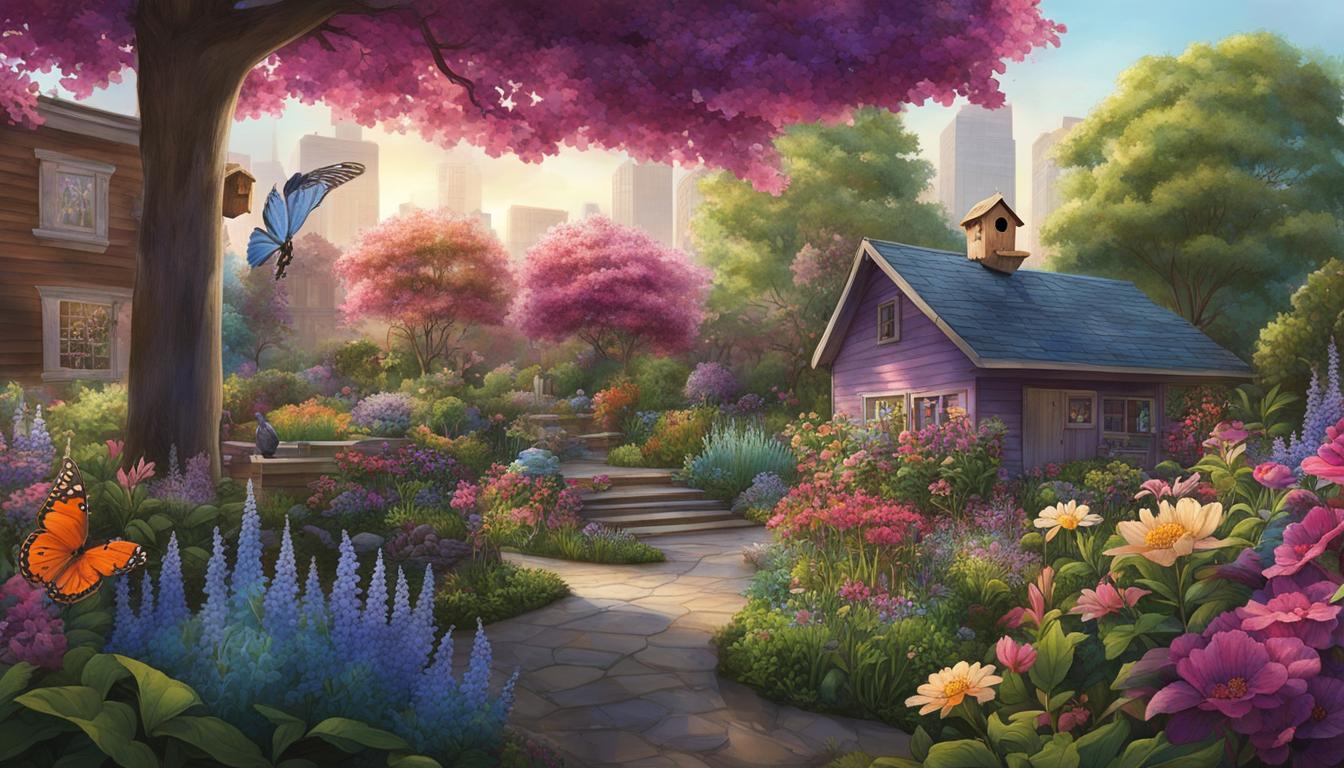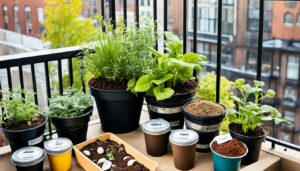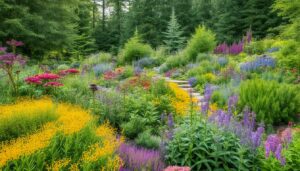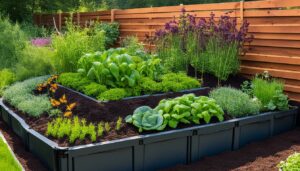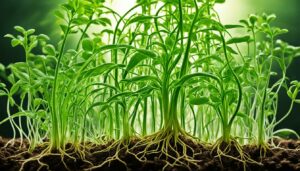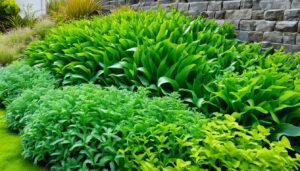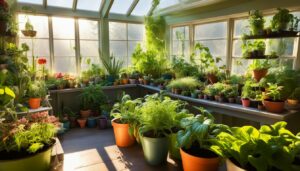In the heart of an urban enclave, where the roar of traffic is the day’s anthem, there lies a serene space that rebels against the concrete jungle—a small backyard transformed into a thriving wildlife-friendly garden. This little patch of paradise doesn’t just boast colorful arrays of flowers and vibrant green shrubs; it’s a bustling microcosm where butterflies dance, bees hum diligently at work, and birds find refuge. It goes to show that even in the smallest urban spaces, eco-friendly gardening tips can give life to garden biodiversity, creating a wildlife habitat that’s beneficial for the environment and the soul.
Indeed, sustainable gardening practices are more than a mere hobby; they’re integral in forging a connection with nature, showing us how we can coexist with the wildlife that’s trying to navigate the urban sprawl. This story of a mini oasis amidst concrete is not just about beauty; it’s about balance and sustaining the ecosystem that sustains us.
Key Takeaways
- Creating a wildlife habitat in urban spaces can significantly boost local biodiversity.
- Wildlife-friendly gardening provides essential resources for various native species.
- Implementing eco-friendly gardening tips can reduce your environmental footprint.
- Sustainable gardening practices like composting and using native plants support ecosystem health.
- A well-maintained wildlife-friendly garden not only attracts fauna but also contributes to cleaner air and reduced urban heat.
The Role of Urban Gardens in Supporting Wildlife
Urban gardens are more than just a splash of greenery in the concrete jungle; they’re dynamic systems that play an indispensable role in attracting wildlife to gardens and enhancing backyard biodiversity. These cultivated areas perform an essential function by bridging the gap between natural and urban environments, encouraging a diverse array of wildlife to flourish right outside our doorsteps.
Strategically incorporating native plant landscaping into urban garden designs is not only aesthetically pleasing but also serves as a critical step towards creating a robust ecosystem. Native species of flowers, shrubs, and trees are ideally adapted to local climate conditions and soil types, making them vital for local fauna seeking refuge and resources in urban settings.
- Providing Natural Habitats: Variety in plant life forms intricate layers of vegetation that replicate natural habitats, offering shelter and nesting spots for birds, insects, and small mammals.
- Attracting Pollinators: Flowering plants native to the region serve as magnets for bees, butterflies, and other pollinators essential for a thriving environment.
- Food Resources: The inclusion of fruit and nut-bearing plants in an urban garden can offer sustenance to a variety of wildlife, establishing a self-sustaining ecosystem.
Moreover, these gardens are a conscious step towards countering the effects of urban sprawl, supporting wildlife by a reduction in habitat destruction. Through the simple act of gardening with wildlife in mind, individuals contribute to a broader conservation effort, directly impacting the ecological footprint of urban areas.
By fostering an environment that treasures biodiversity, we not only bring nature closer to our daily lives but also foster a sense of stewardship towards our shared planet.
As cities continue to grow, native plant landscaping within urban gardens will become increasingly important in sustaining the delicate balance of local ecosystems. Through such efforts, our backyards become more than just spaces for leisure; they evolve into sanctuaries for wildlife and living classrooms for the communities that surround them.
Incorporating Native Plant Landscaping for Increased Biodiversity
Embracing native plant landscaping is a powerful strategy for enhancing garden biodiversity. Not only does it provide a visually appealing landscape, but it also supports a robust, balanced ecosystem right in your backyard. Adopting a pollinator-friendly garden design fosters a thriving environment for local wildlife and contributes to the conservation of our natural heritage.
Benefits of Planting Indigenous Species
Native plants are naturally adapted to their local environment, making them more resilient to climate conditions and less dependent on human intervention. This compatibility results in less water usage, reduced maintenance, and fewer pesticides. The inherent properties of indigenous plants create a harmonious environment for local wildlife, including birds, insects, and small mammals.
Finding the Right Native Plants for Your Garden
When selecting plants for your garden, it’s important to consider factors such as soil type, sunlight, and moisture levels. Local extension offices, gardening clubs, and nurseries can be treasure troves of information for aspiring native plant landscapers. They can help identify species that will flourish in your specific conditions and, subsequently, attract and sustain local wildlife.
Supporting Local Pollinators with Native Flora
By choosing the right native plants, your garden can become a haven for pollinators such as bees, butterflies, and birds. These creatures are not only vital for the pollination of many crops but also for the continued growth and reproduction of the plants within the ecosystem. Native flora offers the perfect sources of nectar and pollen to support these invaluable species.
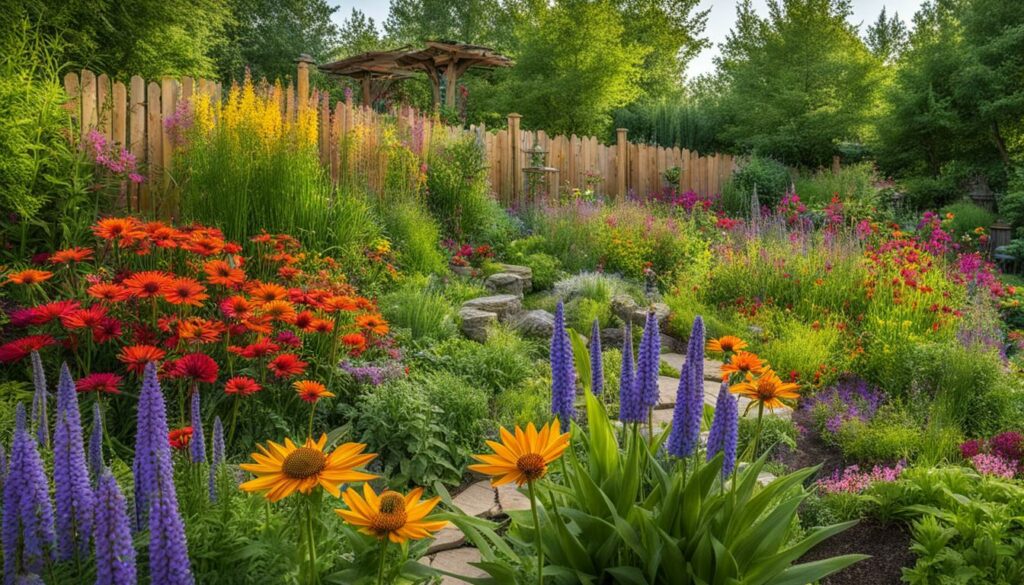
Fostering garden biodiversity with native plant landscaping is a real contribution to environmental sustainability. It enhances the beauty of the natural world around us and ensures the health of pollinators critical to our local ecosystems—a goal worth aspiring to for every ecologically minded gardener.
Creating a Wildlife Habitat with Water Features
Within the tranquil confines of an eco-friendly garden, water features play a pivotal role in establishing a thriving wildlife habitat. These aquatic havens are not just a source of beauty and serenity for us but are vital in attracting and sustaining a diverse array of fauna. From the gentle buzzing of bees to the melodious tunes of birds and the soft croaking of frogs, water features can harmonically blend the sounds of nature into our daily lives, creating an ambience that is both soothing and ecologically beneficial.
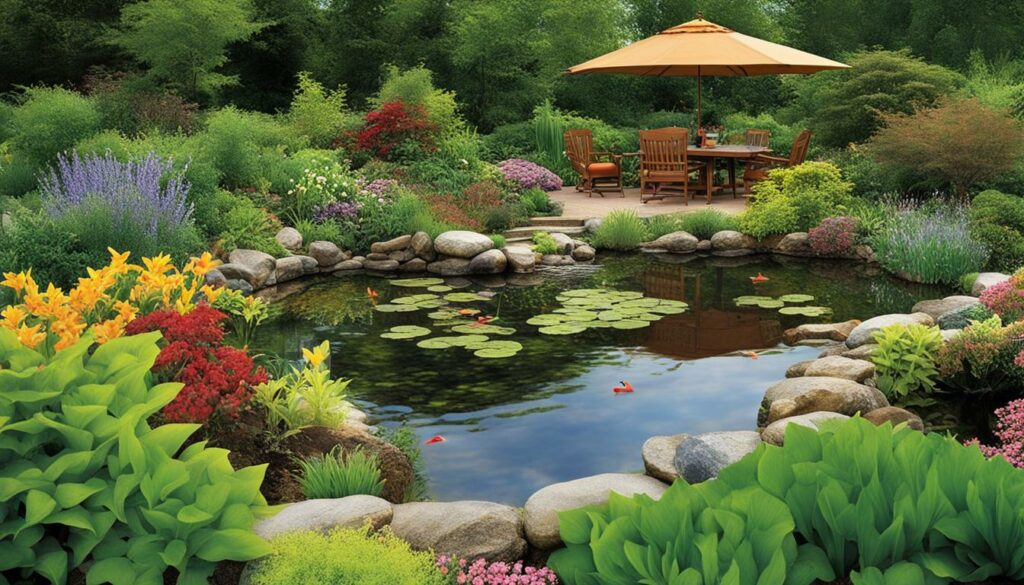
Attracting Birds and Insects with Water Sources
Birds and insects are especially drawn to gardens where water is accessible. Providing basins of varying depths can cater to different species, allowing some to wade and bathe, while others simply sip at the water’s edge. Implementing sustainable gardening practices such as a recirculating system can keep the water fresh and inviting for winged visitors.
Maintaining Eco-Friendly Aquatic Systems
To sustain an eco-friendly aquatic ecosystem, regular maintenance is key. This includes safeguarding the water quality without the use of harsh chemicals, which can be detrimental to both terrestrial and aquatic life. Natural cleaning methods and biological filtration can contribute to clear, healthy waters in an eco-friendly gardening landscape.
Encouraging Amphibian Diversity Through Pond Construction
Amphibians are excellent indicators of environmental health, and their presence often signifies a well-balanced garden ecosystem. When constructing a pond, incorporating local stone and native aquatic vegetation can offer natural shelters and breeding grounds for these sensitive creatures, thus bolstering the local biodiversity.
| Feature | Benefits | Maintenance Tips |
|---|---|---|
| Birdbath | Attracts a variety of birds, provides drinking and bathing spot. | Change water regularly, keep it clean of debris. |
| Backyard Pond | Supports amphibian life, can control mosquito population. | Monitor water levels, manage plant overgrowth, use native fish to balance. |
| Waterfall or Stream | Adds soothing sound, encourages natural water purification. | Check pump system, maintain clear flow paths. |
By integrating these eco-friendly gardening tips and focusing on creating a wildlife habitat, we invite a natural chorus to our gardens while maintaining the balance of our local ecosystems. The water feature, much more than a mere decorative element, becomes a life-giving force and a focal point for ecological gardening efforts.
Ensuring a Safe Haven for Wildlife Through Shelter
Attracting wildlife to your garden extends beyond the flora you plant and the feeders you fill. To practice truly wildlife-friendly gardening, it’s vital to provide sturdy shelters that encourage various species to take residence and thrive within your own backyard oasis. In the pursuit of creating a wildlife habitat, let’s explore various structures that not only offer safety but also enrich the visual appeal of your natural space.
From birdhouses perched among the branches to ground-level hideaways for small mammals and amphibians, each element of wildlife shelter can enhance the quality of life for your garden’s visitors. By building or installing these shelters, gardeners play a key role in attracting wildlife to the garden, serving as dedicated stewards of their local ecosystems.
- Birdhouses: Tailored to suit various species, these provide safe nesting sites, shelter from harsh weather, and protection from predators.
- Bat Boxes: These serve as roosting spots for bats, which are exceptional for insect control and are vital pollinators in certain regions.
- Bee Hotels: Designed to accommodate solitary bees, these structures are crucial for boosting pollination in your garden.
- Brush Piles: A simple heap of branches can offer an ideal hideout for small wildlife such as birds and hedgehogs.
- Rock Piles and Walls: These mimic natural landscapes, providing crevices for small reptiles and insects to find sanctuary.
- Logs and Tree Stumps: Perfect for beetle larvae to thrive, which in turn attracts birds like woodpeckers.
Creating shelters not only supports the ecosystem but also brings a sense of life and robustness to your garden. Observing the habits and interactions of various animals can make the experience of wildlife-friendly gardening all the more rewarding. By investing in these havens, you contribute to a grander vision for biodiversity right in your backyard, enticing a tapestry of living creatures to weave itself over the green canvas of your garden.
Sustainable Gardening Practices for a Healthier Ecosystem
Embracing sustainable gardening practices is more than a hobby; it’s a commitment to fostering an eco-system that flourishes naturally. By integrating eco-friendly gardening tips into daily routines, gardeners play a crucial role in nurturing the environment. These methods go beyond aesthetics to ensure a healthier ecosystem where each element works in harmony.
Alternatives to Chemical Pesticides and Herbicides
The drive to create a garden that’s both beautiful and beneficial to the earth has led many to seek alternatives to chemical pesticides and herbicides. Natural pest control options, such as neem oil or diatomaceous earth, can be used to repel harmful insects while preserving the health of the surrounding wildlife. Pyrethrum, derived from chrysanthemum flowers, is another bio-friendly choice to manage pests with minimal impact on the garden’s ecosystem.
Organic Mulching Techniques and Composting
Organic mulching is a cornerstone among organic mulching techniques, serving as a protective layer that conserves soil moisture, regulates temperature, and nurtures soil life. Composting transforms kitchen and garden waste into rich nutrients, reducing the need for synthetic fertilizers and enhancing soil structure. This practice not only enriches the soil but also decreases landfill waste, promoting a closed-loop system within your garden’s ecosystem.
Water Conservation and Soil Health
Water is a valuable commodity, and water conservation is a principal aspect of sustainable gardening. Efficient irrigation systems like drip lines or soaker hoses target plant roots directly, reducing evaporation and runoff. Collecting rainwater or implementing a greywater system can further minimize the dependence on treated water supplies, fitting seamlessly into an eco-conscious garden plan.
| Sustainable Practice | Benefits | Eco-Friendly Tips |
|---|---|---|
| Natural Pesticides | Protects beneficial insects and reduces soil contamination | Use neem oil to deter pests without harming bees |
| Organic Mulching | Conserves moisture and enriches soil nutrients | Apply a layer of organic mulch to suppress weeds and retain water |
| Composting | Reduces waste and improves soil structure | Start a compost bin to recycle organic waste into a valuable resource |
| Water Conservation | Minimizes usage and protects local waterways | Implement a rainwater harvesting system to collect and reuse water |
Designing a Pollinator-Friendly Garden Space
Creating a flourishing pollinator-friendly garden design begins with a deep understanding of the symbiotic relationships between flora and fauna. By fostering garden biodiversity through native plant landscaping, you invite a dynamic array of pollinators to your outdoor sanctuary. A rich mix of plants not only embellishes your garden with vibrant colors and textures but also plays host to the tireless workers of the ecosystem—pollinators. Deliberate plant selection can ensure blooms throughout the seasons, maintaining a perpetual buffet for bees, butterflies, and birds alike.
In the retreat of your fragrant and bustling garden, refrain from chemical temptations. Pesticides, though sometimes seen as garden guardians, hold grave consequences for the tender and necessary insects that give life to our food sources. Respect for these tiny warriors can be shown through organic solutions that guard their health and, by extension, our ecosystems.
- Choose a variety of native plants that bloom in succession to provide continuous nectar sources.
- Implement varying flower shapes to cater to different pollinator species.
- Host plants that cater to specific life cycle stages, like milkweed for monarch butterflies.
- Set aside areas of untouched ground and install habitats like bee blocks or nesting boxes.
By designing our gardens with pollinators in mind, we create thriving habitats for them and a spectacular view for ourselves, bustling with life, hues, and the serene buzz of nature’s own. Remember, a pollinator-friendly garden transcends aesthetic delight—it is a crucial step toward sustaining the life cycles that nourish our planet.
Conclusion
The journey toward wildlife-friendly gardening is not just about beautifying your outdoor space; it is a significant step towards nurturing an environment teeming with life and diversity. By weaving together the threads of sustainable practices, native plant landscaping, and eco-friendly approaches, each garden becomes a tapestry that reaches beyond individual borders, intertwining with the greater ecological fabric of our communities. Such efforts are pivotal for promoting biodiversity and offer profound wildlife-friendly gardening benefits which, in turn, contribute to the ecological health of urban and suburban areas.
Measuring the Impact of Your Wildlife-Friendly Garden
One can begin measuring garden impact by observing the increased presence and diversity of species—from the flutter of butterflies to the vibrant songs of birds—all finding refuge within the garden’s embrace. This increase in local fauna serves as a tangible indicator of a healthy habitat. Furthermore, the vitality of your plants and the balance of your garden’s ecosystem are clear markers of the success of your eco-friendly endeavors. Appreciating these changes encourages continuity in sustainable gardening and inspires further positive action.
Continuing Education and Community Involvement in Eco-Friendly Gardening
In fostering an eco-conscious community, it becomes imperative to share knowledge and experiences. Community involvement in eco-friendly gardening paves the way for shared learning and collaborative efforts in creating more green spaces. By engaging with community initiatives, workshops, and local gardening clubs, one not only enriches their own understanding but also contributes to a collective movement that champions environmental stewardship. Each contribution, each garden nurtured with care, becomes a beacon for sustainable living, and together, they can forge a future where nature and humanity flourish in harmony.

